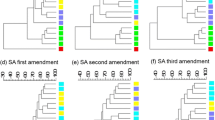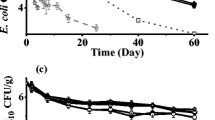Abstract
Seven bacterial strains, most of them bearing natural or recombinant plasmids, were introduced in oak leaf litter or soddy-podzolic soil. In these substrata, which contained litter-dwelling diplopods and isopods, or endogenic earthworms, bacteria survival was followed. In the absence of the animals, the numbers of introduced strains gradually decreased. In the presence of the animals, plasmid-bearing strains of Pseudomonas putida survived at 105–107 CFUs g-1 up to 1.5 months in both leaves and soil. The total numbers of bacteria found in excrements from the soil macrofauna were 5–15 times higher than in the food. The numbers of P. putida in the excrements were equal to or higher than in the food. The numbers of Pseudomonas stutzeri JM302 (pLV1013) and Azospirillum brasiliense ATCC29710 (pFACII) in the excrements were always 2–10 times lower than in the food. The digestive fluid taken from the middle part of the gut of the diplopod Pachyiulus flavipes showed a strong antibacterial activity. Those bacteria with lower survival in the gut appeared to be more sensitive to digestion by the midgut fluid. In contrast, the hindgut fluid did not suppress the viability of P. stutzeri JM302 (pLV1013). We postulate that the introduced bacteria partially survive the midgut passage and then multiply with a high growth rate in the hindgut of the animals. The environmental consequences of the interactions between soil invertebrates and the released bacteria are discussed.
Similar content being viewed by others
References
Anderson JM (1988) Invertebrate-mediated transport processes in soils. Agric Ecosyst Environ 24:5–19
Anderson JM, Bignell DE (1980) Bacteria in the food, guts and faeces of the millipede Glomeris marginata (Villers). Soil Biol Biochem 12:51–255
Anderson JM, Ineson P (1987) Interactions between soil arthropods and microbial populations in carbon, nitrogen and mineral nutrient fluxes from decomposing leaf litter. In: Krivolutzkij DA (ed) (in Russian). Soil fauna of northern Europe Nauka, Moscow, pp 18–33
Bignell DE (1989) Relative assimilation of 14C-labeled microbial tissues and 14C-plant fibers ingested with leaf litter by the millipede Glomeris marginata under experimental conditions. Soil Biol Biochem 21:819–827
Bignell DE, Oskarsson H, Anderson JM, Ineson P, Wood TG (1983) Structure, microbial associations and function of the so-called “mixed segment” of the gut in two soil-feeding termites, Procubitermes aburiensis and Cubitermes severus (Termitidae, Termitinae). J Zool 201:445–480
Byzov BA, Vu Nguyen Thanh, Babjeva IP (1993a) Yeats associated with soil invertebrates. Biol Fertil Soils 16:183–187
Byzov BA, Vu Nguyen Thanh, Babjeva IP (1993b) Interrelationships between yeasts and soil diplopods. Soil Biol Biochem 25:1119–1126
Byzov BA, Dobrovolskaya TG, Chernjakovskaya TF, Zenova GM (1996) Bacterial communities associated with soil diplopods. Pedobiologia 40:67–79
Cane PA, Williams PA (1982) The plasmid-coded metabolism of naphthalene and 2-methylnaphthalene in Pseudomonas strains: phenotypic changes correlated with structural modification of the plasmid pWW60-1. J Gen Microbiol 128:2281–2290
Claus H, Filip Z (1994) Gentransfer bei Bakterien und Überleben gentechnisch veränderter Bakterien im Boden- und Grundwasserbereich: Überlebensdauer, Adsorption und Transport. In: BMFT (ed) Biologische Sicherheit, vol 3. Bonn, pp 35–82
Claus H, Rötlich H, Filip Z (1992 a) DNA fingerprints of Pseudomonas spp. using rotating field electrophoresis. Microb Releases 1:11–16
Claus H, Rötlich H, Filip Z (1992b) Survival in groundwater of some bacteria with natural and recombinant plasmids. Microb Releases 1:103–110
Ditta G, Schmidhauser T, Yakobson E, Lu P, Liang XW, Finlay DR, Guiney D, Helinski D (1985). Plasmids related to the broad host range vector, pRK290, useful for gene cloning and for monitoring gene expression. Plasmid 13:149–153
Doube BM, Stephens PM, Davoren CW, Ryder MH (1994) Interactions between earthworm, beneficial soil microorganisms and root pathogens. Appl Soil Ecol 1:3–10
Doube BM, Ryder MH, Davoren CW, Meyer T (1995) Earthworms: a down-under delivery service for biocontrol agents of root disease. Acta Zool Fennica 196:219–223
Dunn NW, Gunsalus IC (1973) Transmissible plasmid coding early enzymed of naphthalene oxidation in Pseudomonas putida. J Bacteriol 114:974–979
Griffiths RS, Wood ST (1985) Microorganisms associated with the hindgut of Oniscus asellus (Crustacea, Isopoda). Pedobiologia 28:377–381
Hendriksen NB (1995) Effects of detritivore earthworms on dispersal and survival of the bacterium Aeromonas hydrophila. Acta Zool Fennica 196:115–119
Henschke RB, Nucken E, Schmidt FRJ (1989) Fate and dispersal of recombinant bacteria in a soil microcosm containing the earthworm Lumbricus terrestris. Biol Fertil Soils 7:374–376
Ineson P, Anderson JM (1985) Aerobically isolated bacteria associated with the gut and faeces of the litter feeding macroarthropods Oniscus asellus and Glomeris marginata. Soil Biol Biochem 17:843–849
Kozlovskaya LS (1976) The role of invertebrates in organic matter transformation process in marsh soil (in Russian). Nauka, Leningrad
Lavelle P, Gilot C (1994) Priming effects of macroorganisms on microflora: a key process of soil function? In: Ritz K, Dighton J, Giller KE (eds) Beyond the biomass. Compositional and functional analysis of soil microbial communities. Wiley, Chichester, pp 173–180
Lee KE (1985) Earthworms. Their ecology and relationships with soils and land use. Academic Press, Harcourt Brace Jovanovich, Sydney, pp 200–241
Lorenz M, Wackernagel W (1991) High frequency of natural genetic transformation of Pseudomonas stutzeri in soil extract supplemented with a carbon/energy and phosphorous source. Appl Environ Microbiol 57:1246–1251
Nuti M, Rubboldi P (1988) Preliminary trials of field release of Azospirillum brasiliense as inoculant in northern italy. In: Klingmüller W (ed) Risk assessment for deliberate releases. Springer, Berlin Heidelberg New York, pp 46–49
Parle JN (1963) A microbial study of earthworms casts. J General Microbiol 31:13–22
Rötlich H, Claus H, Filip Z (1991) Überlebensdauer einiger gentechnisch veränderter Bakterien in Grundwasser und Boden. Forum Städte-Hyg 42:229–236
Ruschmann G (1953) Über Antibiosen und Symbiosen von Bodenmikroorganismen und ihre Bedeutung für die Bodenfruchtbarkeit. Z Acker und Pflanzenbau 96:201–218
Stotzky G, Babich H (1984) Fate of genetically-engineered microbes in natural environments. Recomb DNA Tech Bull 7:163–188
Striganova BR (1980) Feeding of soil saprotrophs (in Russian). Nauka, Moskva
Taylor EC (1982) Role of aerobic microbial populations in cellulose digestion by desert millipedes. Appl Environ Microbiol 44:281–291
Thorpe IS, Killham K, Prosser JI, Glover LA (1993) Novel method for the study of the population dynamics of a genetically modified microorganism in the gut of the earthworm Lumbricus terrestris. Biol Fertil Soils 15:55–59
Tiedje JM, Colwell RK, Grossman YL, Hodson RE, Lenski RE, Mack RN, Regal PJ (1989) The planned introduction of genetically engineered organisms: ecological considerations and recommendations. Ecology 70:298–315
Tretyakova EB, Dobrovolskaya TG, Byzov BA, Zvyagintsev DG (1996) Bacterial community associated with soil invertebrates (in Russian). Mikrobiologia 65:102–110
Trigo D, Lavelle P (1993) Changes in respiration rate and some physicochemical properties of soil during gut transit through Allobobophora molleri (Lumbricidae, Oligochaeta). Biol Fertil Soils 15:185–188
Vu Nguyen Thanh, Byzov BA, Babjeva IP (1994) The sensitiveness of yeasts at the digestive fluid in the gut of soil diplopods, Pachyiulus flavipes, C. L. Koch (in Russian). Mikrobiologia 63:715–720
Winstanley C, Morgan JAW, Pickup RW, Jones JG, Saunders JR (1989) Differential regulation of lambda pl and pR promoters by a cI repressor in a broad-host-range thermoregulated plasmid marker system. Appl Environ Microbiol 55:771–777
Winstanley C, Morgan JAW, Pickup RW, Saunders JR (1991) Use of a xylE marker gene to monitor survival of recombinant Pseudomonas putida populations in lake water by culture on nonselective media. Appl Environ Microbiol 57:1905–1913
Zvyagintsev DG, Panikov NS, Gorbenko AJ (1987) A quantitative estimation of the influence of invertebrates on the growth of microbial populations in soil. In: Striganova BR (ed) Soil fauna and soil fertility (in Russian). Proceed 9th Intern Colloq Soil Zoology, Nauka, Moscow, Aug 1985, pp 63–67
Zvyagintsev DG, Byzov BA, Tretyakova EB, Filip Z (1994) Fate of genetically engineered bacteria in soil: influence of soil mesofauna on survival and possible gene transfer. Abstr. 3rd German-Russian Workshop Biotechnology, 3–5 Oct 1994. Berlin
Author information
Authors and Affiliations
Additional information
Dedicated to Professor J. C. G. Ottow on the occasion of his 60th birthday
Rights and permissions
About this article
Cite this article
Byzov, B.A., Tretyakova, E.B., Zvyagintsev, D.G. et al. Effects of soil invertebrates on the survival of some genetically engineered bacteria in leaf litter and soil. Biol Fertil Soils 23, 221–228 (1996). https://doi.org/10.1007/BF00335948
Received:
Issue Date:
DOI: https://doi.org/10.1007/BF00335948




